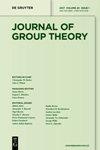有限置换群的第二类商
IF 0.5
3区 数学
Q4 MATHEMATICS
引用次数: 0
摘要
设𝐺是有限集合上的一个置换群,设𝑝是一个素数。本文证明了𝐺的最大二类𝑝-quotient的阶数最多为p n/p p^{n/p}(如果p=2 p=2,则为2 3 × n/4 × 2^{3n/4}),其中𝑛为𝐺的一个Sylow𝑝-subgroup移动的点数。进一步,我们描述了最大的二类𝑝-quotients可以达到这样一个界限的群。这延伸了Kovács和Praeger从1989年开始的早期工作。本文章由计算机程序翻译,如有差异,请以英文原文为准。
Class-two quotients of finite permutation groups
Abstract Let 𝐺 be a permutation group on a finite set and let 𝑝 be a prime. In this paper, we prove that the largest class-two 𝑝-quotient of 𝐺 has order at most p n / p p^{n/p} (or 2 3 n / 4 2^{3n/4} if p = 2 p=2 ), where 𝑛 is the number of points moved by a Sylow 𝑝-subgroup of 𝐺. Further, we describe the groups whose largest class-two 𝑝-quotients can reach such a bound. This extends earlier work of Kovács and Praeger from 1989.
求助全文
通过发布文献求助,成功后即可免费获取论文全文。
去求助
来源期刊

Journal of Group Theory
数学-数学
CiteScore
1.00
自引率
0.00%
发文量
45
审稿时长
6 months
期刊介绍:
The Journal of Group Theory is devoted to the publication of original research articles in all aspects of group theory. Articles concerning applications of group theory and articles from research areas which have a significant impact on group theory will also be considered.
Topics:
Group Theory-
Representation Theory of Groups-
Computational Aspects of Group Theory-
Combinatorics and Graph Theory-
Algebra and Number Theory
 求助内容:
求助内容: 应助结果提醒方式:
应助结果提醒方式:


